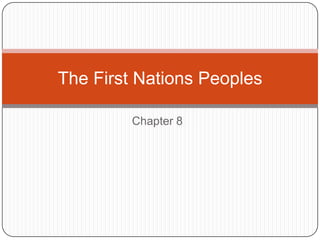
The first nations peoples
- 1. The First Nations Peoples Chapter 8
- 2. Terminology – all are sin ominous American Indian Native American First Nations People
- 3. History at a Glance Native American were indigenous to the Americas. The Europeans moved onto the land quietly at first The governments then willfully decided to try to eradicate the Native Americans Germ warfare was used to try and kill off the population this included Smallpox, measles, and cholera and later would argue Aids/HIV for lack of resources. Cultural Genocide Federal policy to separate native children from the tribe sending them hundreds of miles away to boarding school. This in turn diminished if not eradicated their
- 4. History Continued National policies were put into place to relocate and essentially take over the Native peoples‟ land Two familiar examples: Trail of Tears in the Southeastern part of the United States and The Longest Walk in the Southwest.(1830‟s) 1950‟s the US Federal Government used the law to take over these peoples‟ land. Called the Termination Era
- 5. The Fight Continues The Native Americans were given reservations throughout the United states. They were originally governed by themselves separate from our government called sovereignty. Some still are for instance the Navajo in the southwestern part of the US. Even today, however, the US government is finding ways to move these people and take away their rights that they originally gave them. Infringing on their „indigenous sovereignty.‟ 1970‟s the Alaska Native Claims Settlement Act (ANCSA) manipulated earlier policies which are now weeding out the tribes of Alaska. If born after 1971 the people whether part of the tribes or not have no more rights to the land.
- 6. Overall Outlook Of the Native Americans The native people are very weary of working at all with the US government and its workers including educators. The government continues to take pieces of their culture away and the Native people seem „stuck‟ in a „damned if you do and damned if you don‟t‟ situation. Because of the actions of the US government these people on their reservations are very poor. They are not receiving monies allocated to them. Due to no funding their schooling is poor, the suicide rate is high in many places. The native population has found some ways to provide funding; the casinos for example, but not all natives believe that this is an ethical way of making money. The Us government has offered to pay the Natives to put toxic waste dumps on their land. They would have money, but what would the result in the long run.
- 7. Why should we be culturally sensitive? In order to help these people whether from a social workers position or an educators, we need to understand their past. Why are they so against working with us? Should they trust what we are doing for them? Is it in their best interest or ours? This group of people really have no reason to trust anything that we say. If we understand them culturally then perhaps they will have a little more trust in us. Perhaps we can help where help is needed.
- 8. A long Way Back This culture has almost been destroyed. Our Government needs to step up and make sure that these people are give the rights promised to them and leave their greed to the side. Some of these peoples continue to remain culturally sound. They continue to speak their language, continue to have ceremonies and still live on their reservations trying their best to keep hold of the past. We should not only be sensitive but do what we can to understand and help.
- 9. Education According to the Associate Press the Native population in the continental US and Alaska are the „least‟ serviced in school “The Bureau of Indian Education funds 183 schools for 42,000 American Indian and Alaska Native children on 64 reservations in 23 states. More than 90 percent of the Indian student population attends public schools.” “Indian fourth-graders scored 11 points lower in math than their peers in 2007. By eighth grade, the gap in public schools grew to 17 points.” http://www.foxnews.com/us/2010/06/17/education-officials-say-indian- students-need-standardized-testing-flexibility/#ixzz28IHAFuXV “American Indian and Alaska Native teenagers suffer from poverty, suicide, teen birth, and substance abuse at rates higher than the national average.” “The national graduation rate for American Indian high school students was 50.6 percent in the 2004–05 school year, compared to 77.6 percent for white students.” “Sixty-one percent of American Indian and Alaska Native eighth graders attend schools where more than half of the students are eligible for free or reduced-price lunch.”
- 10. What would you do? I thought that it was interesting that college students were able to do a small exchange type program where they go to live on the reservation for a short time. I would love to do something like this. What a chance to understand a whole culture that is right under our noses, yet we barely think about. If it were up to you what do you think the most important move of the US government should be in order to help this culture find their way back? Do you think that better education of the population may be a key to helping themselves?
- 11. References Associated Press, Washington. Education officials say Indian students need less standardized testing, more flexibility. ©2012 FOX News Network. www.foxnews.com Alliance for Excellent Education. Fact Sheet. American Indian and Alaska Native Students and U.S. High Schools. Updated November 2008. www.all4ed.org Lum, Doman. Culturally Competent Practice. A framework for understanding diverse groups and justice issues. 4th edition. 2011.